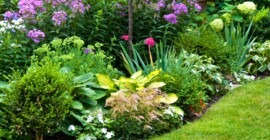Travel the length and breadth of the country visiting garden centres right now, and there will be one thing that becomes obvious to you straight away. It’s bulb-planting season.
Garden centres are stocked full with little dry, brown, round things – and for many gardeners it takes quite a leap of faith to imagine how pretty the garden will look in spring, when all the daffodils, crocuses, muscari, hyacinths, snowdrops, tulips and a wealth of other bulbs are in full colour.
Of course you can plant drifts of bulbs in a border, or plant them in small groups or ‘clumps’ between shrubs and perennials. And some bulbs can be planted in a ‘naturalised’ way, in a lawn (daffodils, miniature narcissi, crocuses and snowdrops are most commonly seen growing this way).
But more and more of us each year are growing our bulbs in containers – patio pots, tubs, urns, troughs and vases, as well as windowboxes and even hanging baskets.
If you want to grow your bulbs in a container, be careful. It is SO important that you choose the right type of compost. Bulbs are notorious for rotting, so it’s really important that you have a free-draining compost that will allow water to run through it easily, and not remain in it to make it a soggy mass of mess!
For most bulbs (but lilies and gladioli especially, I find) I always put down a layer of Westland Potting Grit (available from good garden centres in 20kg bag sizes) in the base of the container. Then I use Westland Bulb Planting Compost to fill the rest of the space. Once these materials are in place, I plant the bulbs – at whichever depth is right for them (usually two-and-a-half to three times their own depth), and one bulb’s width apart).
You might have some multipurpose compost still lying around, left over from earlier in the year, but please don’t be tempted to use it for your bulb containers. It may well be a good potting compost, but it is not always light enough, and free-draining enough, for bulbs.
Westland Bulb Planting Compost, on the other hand, is specially formulated for bulbs – both indoor and outdoor kinds – and contains added grit to improve drainage, as well as the correct balance of essential nutrients and trace elements. It comes in two bag sizes – 10kg and 20kg.
Final tip
Most people, when planting bulbs in pots, just leave it as that. Actually, topping off the planted pot with a half-inch layer of Westland Potting Grit, as a kind of ‘mulch’, will make the pot look properly ‘finished’. More importantly, over the next six months or so, as the bulbs are growing, the odd weed seed will blow in from outside, and start to grow. Pulling up these interlopers through the grit is so much easier – and cleaner.
Read more blog entries…



